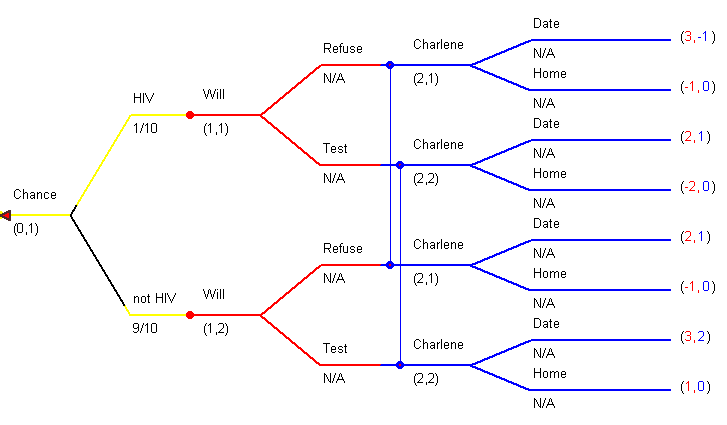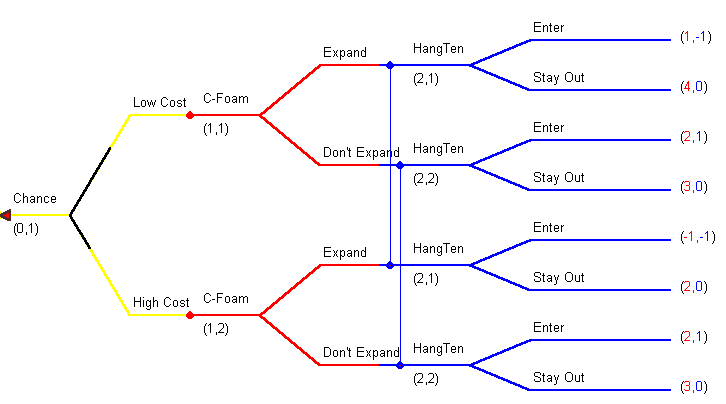Incomplete Information: Part II
A Dynamic Game
|
|
Since we are dealing with a
dynamic game, time plays an important role. Since time is
important and we are considering games with incomplete information, we
have to be concerned with who knows what and when they know it.
Again we distinguish between imperfect and incomplete
information. Imperfect information suggests that we may be making moves at
the same time as our opponent or do not know our opponent's move until our own move
has been made. Incomplete information refers to the possibility that our
opponent's type may be unknown to us, and so we do not know her payoffs.
|
 |
Rules for Information Sets
Because it is so important to know who knows what and
when they know it, we need to impose some rules on information sets.
Rule 1: All the nodes in an information set must
belong to the same player. Any two players must have their own information
sets.
Rule 2: If decision node A is a predecessor of
decision node B, then A and B cannot be members of the same information
set. You can't forget what you or other players have done in the past.
Rule 3: The same set of actions must be available
at each node within an information set. Within an information set the
member nodes must be logically indistinguishable. Suppose nodes A and B
are members of the same information set. From A you can choose either 'up'
or 'middle'. From B you can choose 'middle' or 'down'. If Gretl is at node
A then she knows she can choose between 'up' and 'middle', and therefore she cannot
be at node B. Consequently, A and B are not in the same information set.
Rules for Probabilities: A Review of Bayes Rule
Since chronology and the sequence of moves are important
it may be that we can learn from events that precede the node at which we must
make a decision. Recently Charlene has met Will. She knows that 10%
of the male population has HIV. Her prior probability that Will is
infected is 10%. There is a test for HIV and Will agrees to take it.
It is known that among those with HIV, the test will come back positive 95% of
the time. Among those who do not have HIV, the test returns a positive
result 10% of the time. Will's test has come back negative. How can
Charlene use this information?
Let's write down everything we know.
 |
P stands for probability. The
term in parentheses is an event. The statement is read as 'the
probability that a randomly drawn male has HIV is 10%'. |
 |
The probability that a randomly drawn
male does not have HIV is 90%. The bar over the event HIV
indicates that the event of interest is the complement to HIV, i.e., not
having HIV. |
 |
There are now two events in
parentheses: Having HIV and testing positive for HIV. The vertical line
is read as "given". The probability statement is read as
'Given that a randomly drawn male has HIV, the probability of testing
positive is 95%'. |
 |
Given that a randomly drawn male does
NOT have HIV, the probability of testing positive is 10%. |
Notice in the two conditional
probabilities we have preserved the sense of time: One believes that one
may have contracted HIV, then one is tested.
Actually, we know two more pieces of
information.  means
that in the pool of those with HIV, 95% will test positive. Therefore, in the
pool of those with HIV, 5% will test negative. Or,
means
that in the pool of those with HIV, 95% will test positive. Therefore, in the
pool of those with HIV, 5% will test negative. Or,
 .
.
Similarly,
 means that in the pool of those without HIV, 10% will test positive.
Therefore, in the same pool of individuals without HIV, 90% will test
negative. Or,
means that in the pool of those without HIV, 10% will test positive.
Therefore, in the same pool of individuals without HIV, 90% will test
negative. Or,
 .
.
From
these numbers we can calculate some probabilities that may be of more interest
to Charlene and Will.
From the rules of probability we know that the intersection is equal to
the product of the conditional and the corresponding marginal. In the notation that we have been using
 where the upside down U means either 'and' or 'intersection'. The
probability statement is read 'The probability of testing positive and having
HIV is 9.5%.' We can use this rule to compute the other intersections and
summarize them, as usual, in a table:
where the upside down U means either 'and' or 'intersection'. The
probability statement is read 'The probability of testing positive and having
HIV is 9.5%.' We can use this rule to compute the other intersections and
summarize them, as usual, in a table:
|
|
HIV |

|
|
Test + |
.095 |
.09 |
|
Test - |
.005 |
.81 |
We still aren't home. Charlene is interested in changing the order of
temporal precedence. She wants to be able to revise her estimate of the
probability that Will has HIV given the result of his test. That is, she
is interested in
 .
As
a good student of probability, Charlene knows that she can use
.
As
a good student of probability, Charlene knows that she can use
 to find the answer to her question.
to find the answer to her question.

Given that Will's test has come back negative, there is a 99%
chance that he is HIV-free. Suppose that his test has come back negative,
what would be the probability that he would have HIV? There would only be
a slim chance:

Suppose
that his test has come back positive, what would be the probability that he
would NOT have HIV? The result is perhaps surprising and counterintuitive.

If
you are Charlene, what do you do about Will?
Perfect
Bayesian Equilibrium
The
Dating Game
Let's take a closer look at a stylized dating game between
Will and Charlene. Will is one of two types. He either has HIV or he
doesn't, and he knows which type he is. Charlene doesn't know his type,
but she knows that there is a test that can reveal his type with a high degree
of accuracy. Will asks Charlene for a date. Concerned about her own
health, and not knowing Will's type, Charlene asks Will to have the HIV test
before she will agree to go out with him. With that condition on getting a
date with Charlene, Will must decide whether or not to have the test done.
Even after Will decides what to do about the test, Charlene must decide whether
or not she will date him or stay home. The game tree is pictured below,
and you can get the Gambit game if you click here.

The
player called chance determines whether Will has HIV. This is the Harsanyi
transformation that was introduced in static games of incomplete
information. The lengths of the black line segments in the branches coming
off the chance node are proportional to
the share of the population that has HIV. Under
the rules of what constitutes an information set and what constitutes a subgame,
we can see that there are no proper subgames.
This
is a game of incomplete information since Will knows his type but Charlene
doesn't. It is dynamic since Will agrees to an HIV test, then Charlene
agrees to a date. Notice the structure of the information sets.
Will's acceding to Charlene's request for the test doesn't tell her his type,
but it does say something about his character.
If
Charlene stays home then her payoff is always zero. If Will does have HIV,
refuses the test, and Charlene agrees to the date then his payoff is 3
and hers is -1; he gets the date and she is
at risk for the disease.
If
Will has HIV, agrees to the test, and Charlene agrees to the date then their
payoffs are (2, 1);
Will gets the date and presumably Charlene is well enough informed to avoid
risky behavior. If Will does not have HIV, declines the test, and Charlene
stays home then their payoffs are (-1, 0);
Charlene's payoff is obvious. Will's payoff is -1
since he lost out on the date due to his own pigheadedness. The rest of the
payoffs are reasoned in a similar manner. Before going further we put the
payoffs in tabular form. This is NOT the strategic form of the game since
it does not make use of the strategy profiles for Will and Charlene.
| |
Will |
| HIV |
Not
HIV |
| Take
Test |
Refuse
Test |
Take
Test |
Refuse
Test |
| Charlene |
Date |
1
, 2 |
-1
, 3 |
2
,3 |
1
,2 |
| Home |
0
, -2 |
0
, -1 |
0
,1 |
0
,-1 |
The strategic form of the table is pictured below.
Will's strategies tell him what to do for each of his two types. If he has
HIV he can agree to the test and if he doesn't have HIV he can agree to the
test. That is the first column under Will; (Test,
Test). Each of Charlene's strategies has two moves. The
first corresponds to her move when Will agrees to the test and the second
corresponds to her move when Will refuses to take the test. For example, (Date,
Date) tells Charlene to 'Date' if Will agrees to the test and 'Date' if
he refuses the test. To help you keep things straight I have subscripted the
first row and column strategies.
To determine the expected payoffs consider the first row
and first column cell. Will always Refuses to Test and Charlene always
dates. Her expected payoff is -1(1/10)+1(9/10). Will's payoff is 3 or 2
depending on whether he is HIV or not.
Will's second strategy is to Refuse if he has HIV and
Test if he doesn't. Charlene's second strategy tells her to go out on a
Date whenever she hears Refuse and stay Home whenever she hears Test.
Charlene's expected payoff will be -1(1/10) + 0(9/10). Will's payoffs are
either 3 or 1 depending on whether he has HIV.
| |
|
Charlene |
| |
|
DateRefuse,
DateTest |
DateRefuse,
HomeTest |
HomeRefuse,
DateTest |
HomeRefuse,
HomeTest |
| Will |
RefuseHIV,
Refusenot HIV |
(3,2),
4/5 |
(3,2),
4/5 |
(-1,-1),
0 |
(-1,-1),
0 |
RefuseHIV,
Testnot HIV |
(3,3),
17/10 |
(3,1),
-1/10 |
(-1,3),
9/5 |
(-1,1),
0 |
TestHIV,
Refusenot HIV |
(2,2),
1 |
(-2,2),
9/10 |
(2,-1),
1/10 |
(-2,-1),
0 |
TestHIV,
Testnot HIV |
(2,3),
19/10 |
(-2,1),
0 |
(2,3),
19/10 |
(-2,1),
0 |
Let's do one more cell. Will's third strategy is Test if
he is HIV and Refuse if he is not. Charlene's third strategy is Stay Home
if she hears Refuse and Date if she hears Test. For example, when Will has
HIV he gets the Test and Charlene Dates. Her expected payoff
1(1/10)+0(9/10).
Date, Date dominates Date,
Home and Home, Home for Charlene. Once you
eliminate those two strategies you can see that Test, Test
dominates Test, Refuse and Refuse,
Test dominates Refuse, Refuse.
Continuing with IEDS you will find that the solution to
the game is TestHIV, Testnot HIV and HomeRefuse,
DateTest.
There is one more Nash equilibrium in the game at RefuseHIV,
Refusenot HIV and DateRefuse, HomeTest. Is one
of the two equilibria better, and by what criterion?
For two other versions of the game right click on these
links and open the file with Gambit: 1. In which Charlene
sees the test result and must decide what to do. 2. In
which Will agrees to and produces the test result and
then Charlene decides what to do.
The Surfboard Game Again
The new wave in the game is that HangTen chooses to
enter after C-Foam has decided to expand. But upon seeing C-Foam's new
large plant, HangTen still doesn't know whether or not C-Foam is high or low
cost. The game tree is pictured below and you can click
here to get the Gambit *.efg game file.

The strategic form of the game is
| |
|
C-Foam |
| |
|
ExpandHigh,
ExpandLow |
Expand,
Don't expand |
Don't
Expand, Expand |
Don't
Expand, Don't Expand |
| HangTen |
EnterExpanded,
EnterDidn't Expand |
-1,
(-1,1) |
1/3,
(-1,2) |
-1/3,
(2,1) |
1,
(2,2) |
| Enter,
Stay out |
-1,
(-1,1) |
-1/3,
(-1,3) |
-2/3,
(3,1) |
0,
(3,3) |
| Stay
out, Enter |
0,
(2,4) |
2/3,
(2,2) |
1/3,
(2,4) |
1,
(2,2) |
Stay
out,
Stay out |
0, (2,4) |
0,
(2,3) |
0,
(3,4) |
0,
(3,3) |
Stay out, Enter is
HangTen's dominant strategy. HangTen believes that Expand,
Expand is dominated by Don't Expand, Expand
for C-Foam. Also Expand, Don't expand is dominated by Don't
expand, Don't expand. From this HangTen is able to conclude that
C-Foam will never expand when their cost of doing so is high. Once C-Foam's
dominated strategy is eliminated, and keeping in mind HangTen's dominant
strategy, it becomes apparent that C-Foam will play Don't
expand, Expand. The IEDS equilibrium, which is a Nash equilibrium, is
highlighted.
There are other Nash equilibria in the game.
Consider the following table of best responses:
| HangTen |
C-Foam |
| b(X,
X) = (S,E) and (S,S) |
b(S,E)
= (X,X) and (D,X) |
| b(X,D) = (S,E) |
b(E,S) = (D,D) |
| b(D,X)
= (S,E) |
b(S,S) = (D,X) |
| b(D,D)
= (E,E) and (S,E) |
b(E,E)
= (D,D) |
The other two Nash equilibria are highlighted
in the normal form of the game. The other two Nash equilibria are not
plausible. Does it make sense for C-Foam to expand when the cost of doing
do is high? Does it make sense for HangTen to enter no matter what, or for
C-Foam to never expand? Since there are no proper subgames, all three of
the Nash equilibria are subgame perfect by default.
How would we resolve the problem of a multiplicity of
Nash equilibria when we are unable to apply IEDS?
There are two non-trivial information sets, labeled (2,1) and (2,2) in the
diagram. Information set (2,1) corresponds to HangTen observing that
C-Foam has built more capacity. Information set (2,2) corresponds to the
observation that C-Foam has not expanded. Before the game is played
HangTen believes that there is a 2/3 chance that C-Foam is low cost.
HangTen might want to revise that prior once they have seen that C-Foam has
added capacity. Indeed, from the normal form of the game we concluded that
C-Foam would never expand if it was high cost. From the rules of
probability HangTen would then find that P(Lo|Expand) = 1. HangTen's full set of
revised probabilities would be called its belief profile.
This brings us to the definition of a perfect Bayes
equilibrium:
1. The collection of strategies constitute a Nash
equilibrium, given the player's beliefs.
2. At each player's information set, the move required
by the player's strategy maximizes that player's expected payoff, given that
player's beliefs and the other player's startegies.
3. Every player's beliefs can be derived from the
equilibrium strategy profile and the common prior beliefs.
Neither {(Expand, Expand),
(Stay out, Enter)}
nor {(Don't expand, Don't expand), (Enter,
Enter)} has a belief profile that would be part of a perfect Bayes
equilibrium.
The methods of dynamic games with incomplete information
have been used to study the market for
lemons. Usually the terminology refers to the market for cars,
principally used cars, but it can also be used to study labor markets and the
market for bank loans.



